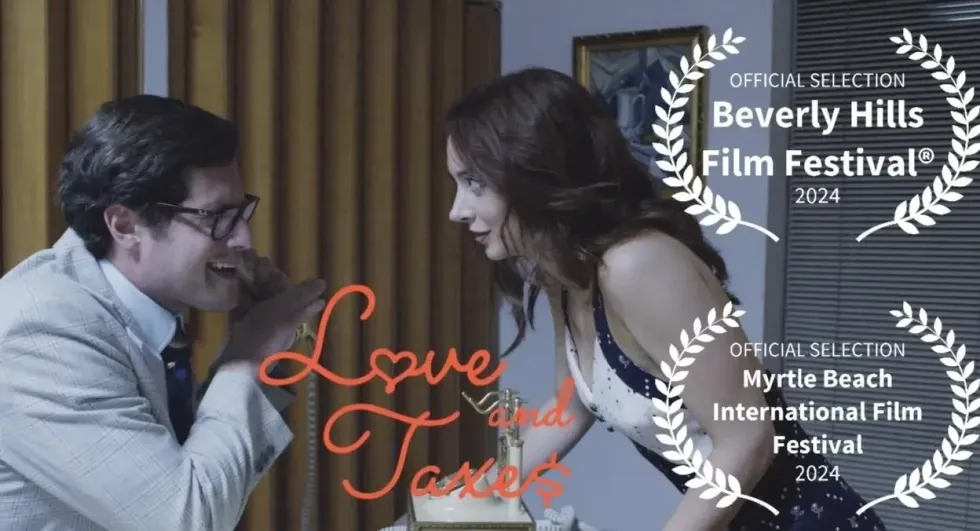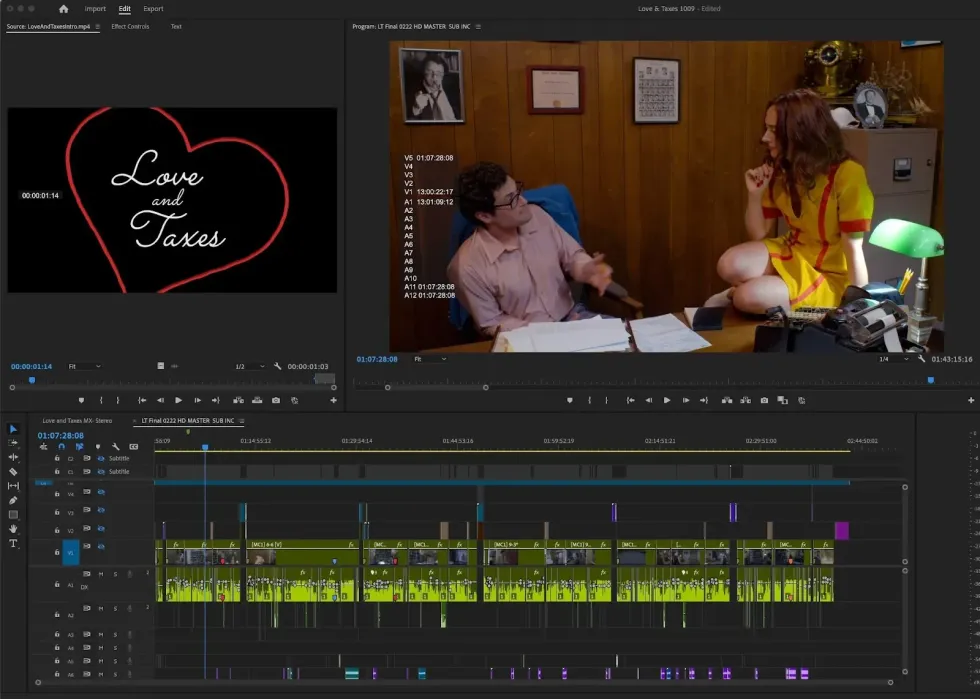
This post was written by Michelle Gallina and originally appeared on the Adobe blog on August 15th, 2024.
With each passing year, these sessions evolve into much more than just taxes.
We had the opportunity to speak with Craig Tollis, the director and editor of “Love and Taxe$,” about the unique aspects of creating this film using Adobe Premiere Pro and Adobe After Effects. What makes the process unique is that each scene was shot in a single continuous take, and editing techniques were applied to generate specific scene backgrounds. These backgrounds were then placed behind greenscreen photos using Adobe Photoshop.
Notably, the film won several awards at the Myrtle Beach International Film Festival this year, including “Best Comedy,” “Best Actress,” and “Best Actor in a Comedy.” Read on below for a behind the scenes look at this award-winning film.
How and where did you first learn to edit?
I was in the media production program at a small arts college in Atlanta, Georgia a long time ago. We had classes on tape-based editing and a 10-week course on a nonlinear system, which was the up-and-coming technology of the time. My first editing job was as an assistant and junior editor for a small production company making news packages, commercials, and long-form documentaries. This experience was invaluable for learning about story structure and relationships with clients and producers.
How do you begin a project/set up your workspace?
I have a numbered folder structure that sorts sequences and elements, like music and sound effects, in more or less workflow order. Then, I organize the footage depending on the type of the project. I like to have two monitors with large playback and timeline on the right, then bins and tools on the left. On long-form projects, it’s really crucial to be organized from the start.

Tell us about a favorite scene or moment from this project and why it stands out to you.
Jake Reiner (Donald) and Alexis Abrams (Belinda) are the two main characters in the movie and the only people we see speak directly. Lloyd Schwartz’s script was written that way, and Ken Feinberg, my directing partner, and I wanted to stay true to that. It was a great creative experience to stay true to Lloyd’s vision.
Jake and Alexis both give great performances throughout the movie and did an amazing job of running 15 or 20 minute continuous takes, which is just exceptional.
My favorite Jake/Donald moment is when he’s trying to be seductive and failing at it. It’s a surprise for Donald to be on the offensive in the relationship, and Jake really went for it. There are a lot of emotional twists and turns as he switches between tactics, being assertive or playing for sympathy. We see a lot of Jake Reiner’s acting range in that scene, and it’s a fun cat-and-mouse game between him and Alexis.
Alexis has some great fun moments where Belinda’s telling stories about Vance’s Diner, where she initially works and ends up the owner. Because of the style of the movie, we only see Vance in stills in the passage of time montages. So, Alexis has it all on her to take us on a journey into that world with her stories and her mischievous energy is just captivating.
The big fun scene in the movie is Donald and Belinda scheming to find out whether Donald’s wife is cheating on him. Donald phones the house where he thinks his wife is and invents a fake TV show competition about French history (his wife’s favorite subject) to lure her into giving herself away. He and Belinda go into full game-show host mode. It’s a complete change of pace for the movie, some big laughs, great performances, and then hugely ironic when they “succeed” in proving Donald’s wife is cheating! Hurrah!
Jake and Alexis put an amazing amount of work into this movie in a short amount of time. They pulled off something exceptional to play out all these scenes in only three days and put that much energy and attention into each moment.
What were some specific post-production challenges you faced that were unique to your project? How did you go about solving them?
Our writer and producer, Lloyd Schwartz (from “The Brady Bunch” and “Gilligan’s Island”), wanted us to shoot each of the movie’s seven scenes in one continuous shot. This meant we had an editing workflow with single clips that were up to 20 minutes long, but had scaling, repositioning, and speed changes that had to be unnoticeable within each clip. It took quite a lot of work to make these as smooth as possible.
What Adobe tools did you use on this project and why did you originally choose them? Were there any other third-party tools that helped enhance your workflow?
We edited in Premiere Pro and used motion graphics templates, did some VFX in After Effects, and completed photo editing and greenscreen replacement in Photoshop. I’ve worked with Premiere Pro before and wanted to try out Premiere Pro on a feature length project. The integration with After Effects and Photoshop is a huge advantage, as is the availability of a wide range of motion graphics templates. We used Midjourney for AI generated scene backgrounds, cleaned them up, and placed them behind our greenscreen photos using Photoshop. Photoshop’s AI features were also handy when working with the greenscreens, adding custom elements to the AI images, and cleaning up artifacts.

If you could share one tip about Premiere Pro, what would it be?
The transcription and text editing features [Speech to Text] are a really great addition. It allowed me to navigate a feature length timeline with very long clips by looking at, or searching, using dialog. It’s also very useful if you’re editing music and need to find specific lines in songs.
Here’s a boring but crucial tip — get your settings and project organization right when you first start. You’ll thank yourself later, or at least not be mad at yourself later.
Who is your creative inspiration and why?
I learn something new from everybody I work with. On one of my first jobs, my senior editor made a close up of a character’s eyes out of a piece of pre-roll footage where the camera operator had been checking focus. That moment taught me how to see footage differently and find creative solutions to problems.
On this project, our creative inspiration was Lloyd Schwartz — he brought some old school Hollywood class to the set. Plus, he’s full of stories and jokes. We had a great cast and crew and a great vibe throughout the project, which is really what filmmaking should be about.

What’s the toughest thing you’ve had to face in your career and how did you overcome it? What advice do you have for aspiring filmmakers or content creators?
It’s hard to get established and to make it through the learning process on your first projects. You want to find great people who you can trust and work with again and again. I was lucky to be brought onto this project by my good friend and directing partner, Ken Feinberg. This is the 40th film that Ken and I have made together. This is a “who you know” business, and you want to know great people and keep them around.
The toughest thing I’ve had to face in my career has been the chaos of post-Covid Hollywood, followed by the writers’ and actors’ strikes. The industry is really taking a pounding right now, and I hope this doesn’t discourage the next generation of filmmakers. We need you to believe in yourselves, believe in the art of filmmaking, and tell the stories that mean the most to you.
Share a photo of where you work. What’s your favorite thing about your workspace and why?
It’s amazing to see the amount of editing and post-production power that you can have on a computer in your house nowadays. When I started out, a non-linear editing computer cost $60,000 and was probably in a specialized facility somewhere. Now, we can tell stories from anywhere, or from the comfort of our own homes.

Author: Sponsored Content
This article comes from No Film School and can be read on the original site.
